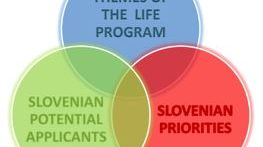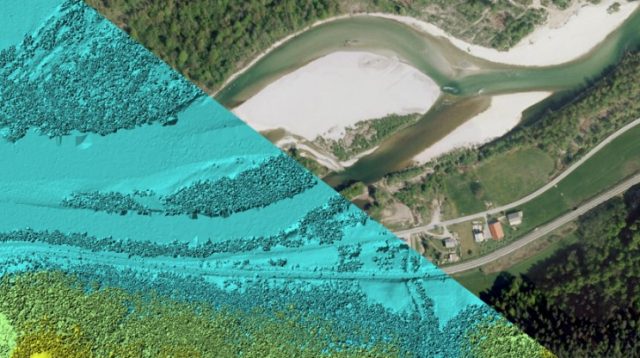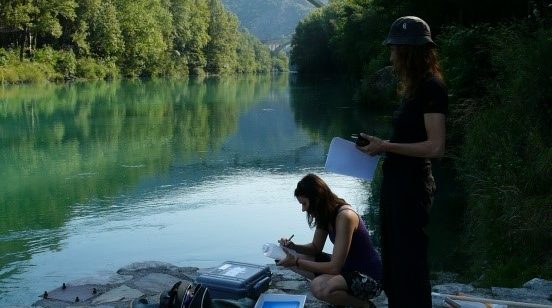Erosion Warning Map

With respect to flood and erosion areas, the rules on methodology stipulate that the flood and erosion hazard assessments should be shown on the flood and erosion warning maps and that these should be used along with the criteria stated in the rules to identify which hazard and risk areas are important so that more detailed analyses can be made for them. The project task has been created with the aim of providing expert bases for implementing Article 83 of the Waters Act, which among other things stipulates the determination of areas that are at risk due to erosion caused by fresh and marine waters. The erosion warning map is defined in greater detail by the rules on methodology (OG RS, No. 60/2007), which state that the warning map must be initially prepared on the basis of analysis of historic and archive data on erosion events and based on prior studies, research, analyses and other data. The map is to be updated at least every six years. The primary objective of the task was to create a draft erosion warning map on a scale of less than 1:50,000 for the entire national territory, which can then be professionally examined and officially published in the Environmental Atlas.
The results of work on the task in 2008–2012 are a great professional baseline for making an erosion warning map at the national level. The basic project task was completed in mid-2008, while the work was done in three stages that lasted from 2008 to 2012. Baselines for future work on expert bases required to make a warning map were also provided. The content of the task is a major contribution to the implementation of the provisions of the rules on methodology, the decree on conditions and limitations, the decree on the content and method of preparation of the FRMP and the rules on the content of applications for acquiring project conditions and water permits. The task consisted of the content sets:
1. Overview and analysis of the existing situation in describing erosion hazards in Slovenia.
2. Making of a list of the existing data sources and obtaining the available data records.
3. Comparing the methodologies for erosion data capture, processing, presentation and use with the methodological approaches of other countries, in particular the neighbouring Alpine countries.
4. Making of a proposal for the content, structure and method of presenting data on erosion on a warning map while taking into account the actual and the potential depth and riverbank erosion from fresh and marine waters, the possibility of slips and landslides in the wider catchment of watercourses and the sites where erosional debris is temporarily deposited – in ravines, on slopes and silt disposals below mountain walls, on torrential cones, etc.
5. Making of a draft erosion warning map as stipulated under Article 8 of the Rules.
6. Making of proposals for further work in the preparation of the first official erosion warning map.
Results of Stages I and II:
1. Breakdown of the situation in how erosion hazards in Slovenia are addressed
2. 33 data sources associated with erosion issues have been collected and analysed
3. Proposal for content and draft warning map: “EROSION: protection areas – measures and restrictions”
4. Analysis of the methodological approach and the results of making the erosion maps in accordance with the 2007 Rules (source 0033)
5. Analysis of the various aspects of presenting the erosion issue in relation to the 2007 Rules (“erosion associated with flooding”) with respect to:
1. Processing level (local, regional, national)
2. Actual : potential erosion
3. Surface : linear erosion
4. Torrential erosion (the specifics of torrential processes and phenomena)
5. Role and significance of forest areas (protection forests, forests with a protective function and potential erosion areas)
6. Significance of data on flood and erosion events
7. Significance of data on water infrastructure
8. Division and “interaction” between areas prone to flooding, erosion, landslides and avalanches
It was found that the entire Slovenian territory is covered only by data from three maps created in 1999. In 2001, these maps were put forward as part of water management content to be used in the Slovenian spatial plan. Data types include surface erosion and partly also torrential erosion (eroded areas, erosion sources), landslide erosion (conditionally stable and unstable land), snow erosion (avalanche paths) and rockfall erosion. Data from these three maps was used as a foundation for further work in 20 processed sources and directly included (though usually modified and supplemented) in 14 processed sources. This data therefore really is used in practice, either in the methodological sense or as a starting point for more detailed processing. The included data on avalanches is of high quality, but the rest is not directly transferrable to a more detailed level, and a critical assessment is necessary in each case. Furthermore, in some of the areas the map is incomplete, generalised or fails to cover the whole problem of erosion in Slovenia. Despite this, however, the map serves as a foundation that we already have at our disposal and that can be upgraded, supplemented and updated in the future. An update would be carried out by generalising the results of more detailed mapping processes (at the municipal level) on smaller scales or by assessing erosion hazards at the national level (processing of data on watercourses – lines – and water drainage zones – torrential areas).
Results of Stage III:
The following data has been considered when determining linear erosion:
1. Average annual precipitation
2. Slopes
3. Erosion coefficient Z along watersheds
The discussed factors are certainly not enough to correctly rank and index stream channels considering the complexity of the erosion problem. In terms of the erosion warning map for Slovenia, all torrential streams should be part of strict protection zones, which includes actively eroding channels with progressive erosion processes, actively eroding channels with predictable potential erosion processes, relatively stable channels without noticeable deepening or deposition, sections featuring phenomena such as sediment retention and gravel retention basins, sections with torrential erosion in channels (riverbank erosion – erosion cracks) and torrential cones.
Linear erosion is shown in three levels:
1. Level 3: Warning areas with strict protection
2. Level 2: Warning areas where complex protective measures are implemented
3. Level 1: Warning areas where standard protective measures are implemented
The developed method needs to be upgraded with appropriate data to ensure proper accuracy, precision and spatial coverage. This primarily includes indexable data that would be available for the area of Slovenia:
1. Precipitation intensity (48-hour precipitation)
2. Runoff coefficient
3. Data on the presence and state of water management infrastructure (particularly the locations of key sediment reservoirs, sediment reservoirs/stabilisation structures and erosion prevention structures in the system)
4. Data on past events related to the watercourse
Link to Additional Content:
1. Erosion Warning Map (2008–2012). Annual Report on Work on Task I/2/2.3, Task Leader: Blažo Đurović. Institute for Water of the Republic of Slovenia, January 2013. Client: Ministry of the Environment and Spatial Planning, Programme of Tasks of IWRS for 2008–2012.
2. PUH (2008). Erosion Warning Map – Stage I. Final Report on the Project Task. Podjetje za urejanje hudournikov, Ljubljana.
3. PUH (2010). Erosion Warning Map – Stage II. Final Report on the Project Task. Podjetje za urejanje hudournikov, Ljubljana.
4. PUH (2011). Erosion Warning Map – Stage III. Final Report on the Project Task. Podjetje za urejanje hudournikov, Ljubljana.
Project Staff:
Darko Anzeljc, Jože Papež, MSc, (Podjetje za urejanje hudournikov)
Related Content:
1. Flood Warning Map. Annual Report on Work on Task I-2-3-1-1, Task Leader: Darko Anzeljc. Institute for Water of the Republic of Slovenia, December 2007. Client: Ministry of the Environment and Spatial Planning, Programme of Tasks of IWRS for 2007.
2. Amendment and Supplementation of the Flood Warning Map. Annual Report on Work on Task I/2/2.1, Task Leader: Darko Anzeljc. Institute for Water of the Republic of Slovenia, November 2012. Client: Ministry of the Environment and Spatial Planning, Programme of Tasks of IWRS for 2012; Available at: http://evode.arso.gov.si/direktive/FD_tabela.htm
3. Preliminary Assessment of Flood Risk. Annual Report on Work on Task I/3/1, Task Leader: Darko Anzeljc. Institute for Water of the Republic of Slovenia, December 2011. Client: Ministry of the Environment and Spatial Planning, Programme of Tasks of IWRS for 2011.
Keywords
About the Project
Project Library
Photo Gallery



